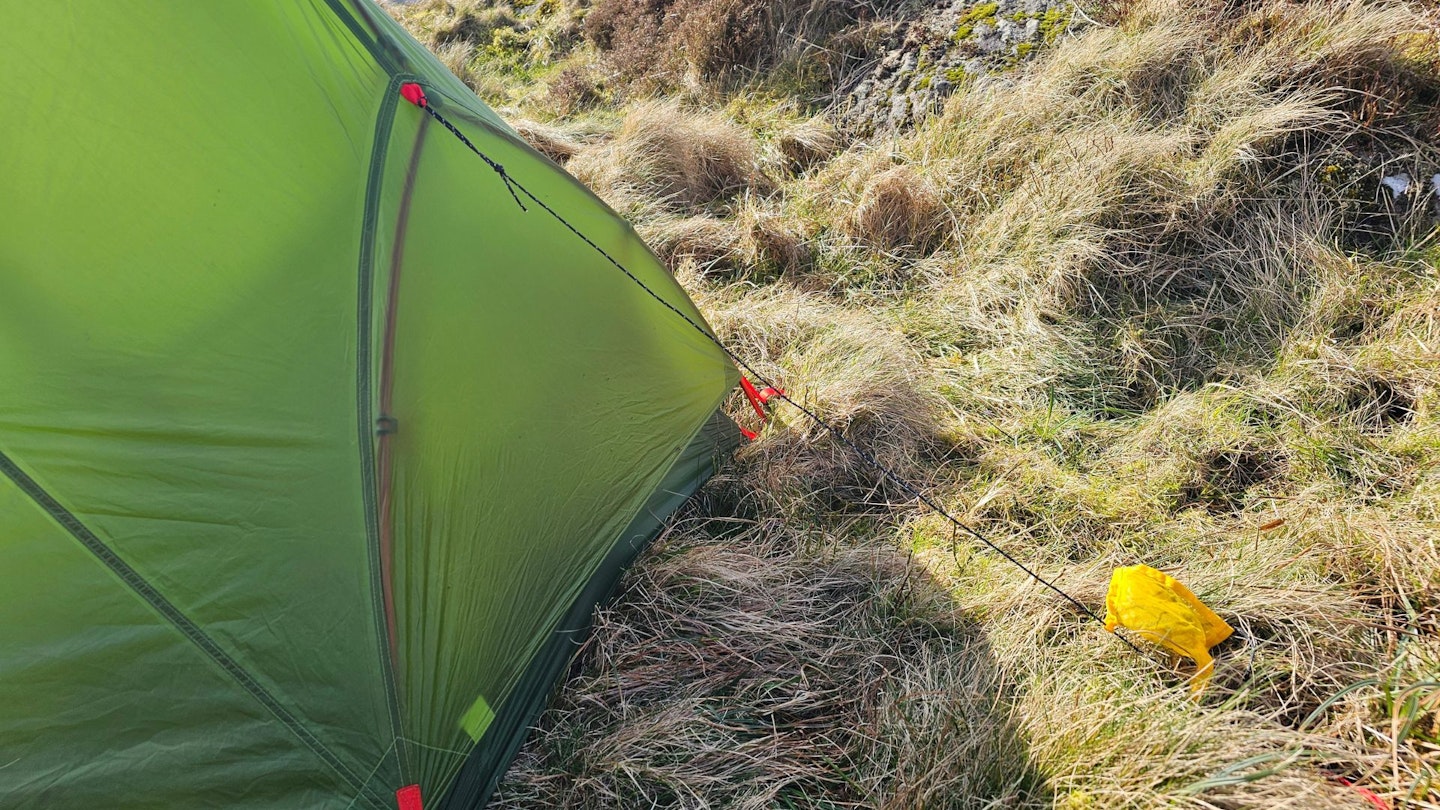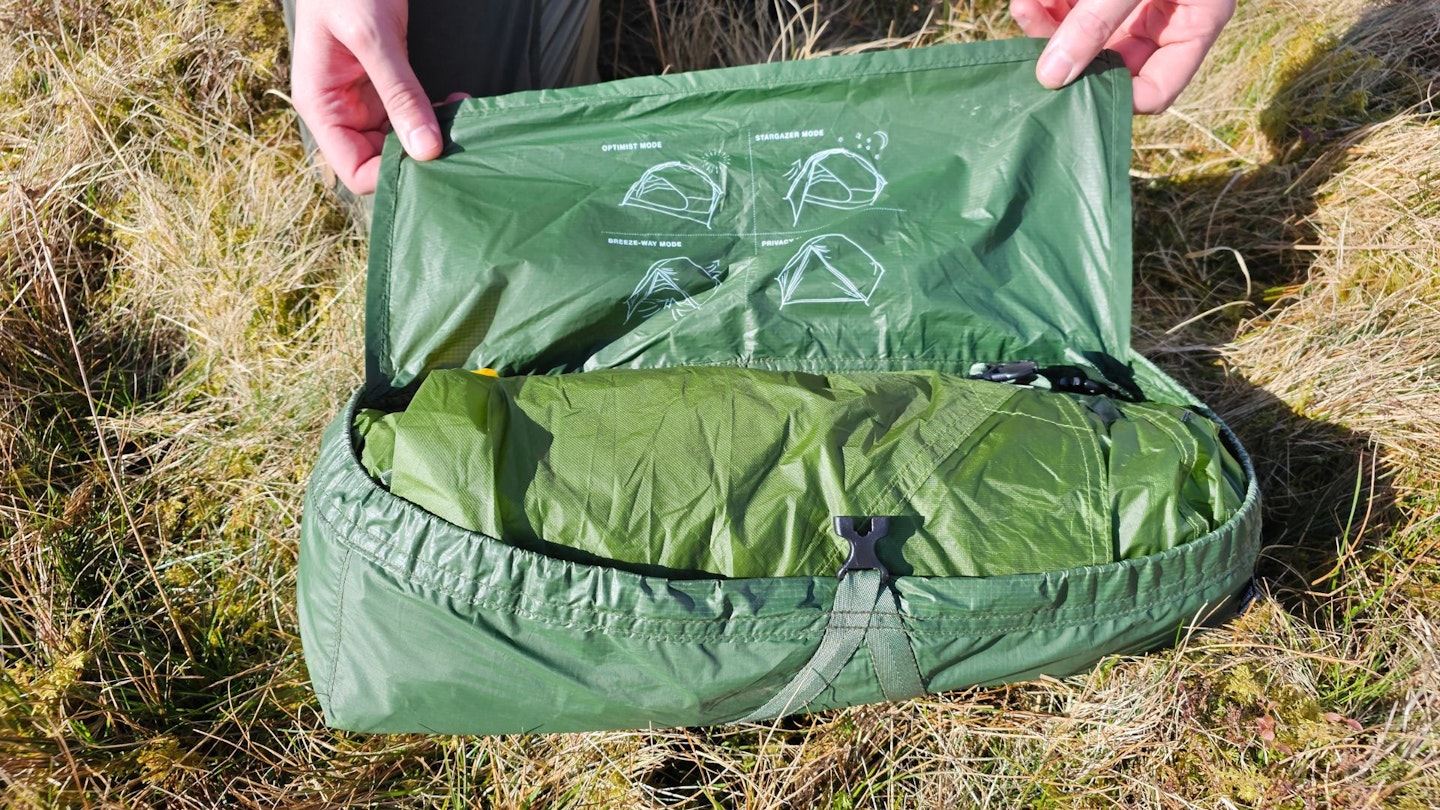Exped is a Swiss outdoor gear manufacturer with an excellent reputation among outdoorsy types, especially for its superb range of sleeping mats. However, the brand also makes a well-regarded series of tents. The one tested here is the Mira 1 HL (‘Hyperlite’), and is a lightweight backpacking tent that Exped says is “perfect for short trips in moderate climates”.
That suggests a design suitable for 2-to-3 season use, primarily for overnight wild camps or backpacking trips from a few days up to a couple of weeks in duration. The latest model has a commendably light packed weight of 1.15kg (2.54lbs) but is also intended to offer a balanced combination of space, comfort and trail liveability.
 LFTO
LFTOwww.alpinetrek.co.uk
Pros
- Good headroom
- Good flysheet coverage
- Practical features including clever rear vestibule design
Cons
- Not the toughest tent
- Inner is fairly narrow
- Steep rear wall can catch the wind
| Type | Freestanding |
| Weight | 1.15kg |
| Packed size | 37 x 13cm |
| Doors | 1 |
| Vestibules | 1 |
| Inner | 15D ripstop nylon and 15D No-See-Um mosquito mesh, DWR C6, flame-retardant free |
| Fly | 10D ripstop nylon (silicone and PU coated), 1500mm HH, PFC-free and flame-retardant free |
| Groundsheet | 20D nylon (silicon and PU coated), 1200mm HH, PFC-free and flame-retardant free |
| Poles | DAC Featherlite NFL 8.7 mm TH72M, green anodizing |
Design and features

The Mira 1 HL is a familiar design with a tripod hubbed pole set and an integrated overhead spreader bar. This is tried and tested geometry for a one person tent, delivering good space to weight. It primarily pitches inner first, using plastic snap clips to attach the inner tent to the pole structure. This is the quickest and easiest method. However, it is possible to pitch the tent outer first, or even just using the fly in combination with the footprint. This would help to keep the inner tent dry if pitching in the rain – though it’s a bit of a faff.

Unfortunately, the design lacks the additional corner struts that you get with some similar rival designs (like the Sea to Summit Alto TR1, for example). This means that the foot end slopes away more sharply, giving you a little less internal space. Despite that slight shortcoming, liveability is still decent. There is an impressive 105cm of headroom at the apex, while the footprint is a true rectangular shape with a total internal length of 215cm and a width of 70cm. There’s ample room for a six-footer to both sit upright and lie out straight.
You also get a good-sized porch or vestibule, augmented by a small secondary vestibule at the back of the tent, which can be accessed via a reach-through zipper. This gives quick access to smaller items like water bottles. There are also two storage pockets at the head end and a handy gear hanging line, which comes pre-attached to the ceiling.

The upper two thirds of the inner tent are made from mosquito mesh to ensure it feels airy and well-ventilated, while still offering effective protection from midges, mosquitoes and other bugs. On the flipside, it can be a little draughty in colder weather. The lower third of the inner is made from 15-denier ripstop nylon fabric to mitigate this. Once hunkered down in your sleeping bag, you can certainly avoid the worst of any draughts that do come through the tent.

The flysheet door has a strut at the top, enabling you to prop the zipper open and create a vent for better airflow on warm, humid nights. The flysheet door is also fitted with a two-way zipper to further improve ventilation. The inner has a large, D-shaped doorway for easy entry/exit. It’s a bit of a shame that the Mira 1 HL lacks the useful door clips found on Exped’s bigger tents though, which are far less fiddly than the standard toggles or tabs.
The practical porch design ensures that the inner remains covered from rain even if the flysheet door is unzipped, which is a flaw that lets many other tents down.
Performance

The tent is well-built, with reinforced pegging points and sturdy webbing used at other critical points throughout. Tensioning buckles and handy yellow mesh pouches attached to the guy lines make them easy to stow quickly without having to coil them up. This is great for quick set-up and pack-down, making it a practical choice for life on the trail when you want to pitch up late and get off early the next morning.
The flysheet provides good all-round coverage and the design is adequately stable for three-season use – though the steep rear wall can catch the wind, and lacks an upper guy line attachment point that might otherwise help to prevent this side of the tent from buckling.

The light green colour of the tent is a sensible choice for inconspicuous wild camps, as it blends in fairly well against grassy hillsides and other upland vegetation. However, it is quite a bright hue, which seemed to attract more bugs than darker, more muted colours.
Overall liveability is good, though the inner is slightly narrower than many rival tent designs. The weight and pack size are excellent for a one-person tent though.
The fabrics are fairly thin and delicate, but then again this is an ultralight solo tent. You can’t have it all. Just bear in mind that it will require more careful pitching and TLC than a heavier shelter. Still, the sil-nylon flysheet offers good tear strength for its low weight, especially compared to cheaper polyester, though it does stretch a little in wet conditions.

Overall, the Mira 1 HL ought to be reasonably durable, though it isn’t the toughest hiking tent you’ll find. Of course, the trade-off is that very low weight and compact packed size. You can also boost the tent’s durability with the addition of a groundsheet footprint (sold separately for an extra £45 and adding an extra 175g in weight), which is recommended by the manufacturer. We’d definitely advise using this, not least because the groundsheet’s worryingly low waterproof rating of 1200mm hydrostatic head seems liable to seepage in very damp conditions, particularly with the pressure of a sleeping mat and human body on top of it.
Sustainability

This tent is made in Vietnam by the CampTec (Tai Chung Canvas Co., Ltd), a professional tent manufacturer that was established in 1952 in Taiwan. Exped offers a 5-year product warranty.
The brand is an acknowledged industry leader in sustainability. In fact, Exped calculates all climate emissions from the production and transportation of this product and finances certified climate protection projects through Myclimate to an equal extent.
The majority of the materials used are PFC-free (perfluorinated compounds, a group of harmful chemicals that are often used for waterproofing), though the specs suggest that the inner does contain a C6 durable water repellent coating, which is a short-chain PFC.
The tent is also free from fire-retardant chemicals. Tent fabrics are commonly treated with these chemicals to improve their ability to withstand exposure to heat, flames and sparks. So, although their omission might be seen as a drawback, many consumers have been concerned by the fact that fire retardants use toxic chemicals that have been linked to carcinogens and complications with pregnancy.
Price and competition

With an RRP of £580, this is a top-end solo tent. In fact, it was the most expensive option in our 2024 test selection, outpricing other high-end lightweight one-person tents from NEMO, Sea to Summit and MSR. However, as with almost any bit of outdoor kit, shopping around will often result in finding a better deal.
Other options exist that are a bit tougher and offer better value. One of the best is the Wild Country Helm Compact 1, which won our Tent of the Year award for 2023. The Helm Compact family is good value but also uses tough fabrics and have good waterproof ratings while remaining reasonably lightweight. It’s arguably a better three-season tent for changeable conditions. On the other hand, it’s significantly heavier and uses more basic materials and components. It’s also not as spacious as the Mira 1 HL.
If you want a tent of a similar design with a comparable packed size and weight to the Exped Mira 1 HL, the MSR Hubba NX Solo and Sea to Summit Alto TR1 Plus are hard to ignore. Both are slightly roomier overall than the Mira 1, and a bit cheaper too.
Verdict

The Exped Mira 1 HL is a well-built tent with good liveability, low weight and a small packed size. It also has a couple of unique design features that set it apart from the competition. On the other hand, it’s not cheap, and there are rival solo shelters that offer similar characteristics at a lower price point.
Shop this product
How we tested

We borrowed a test sample of the Exped Mira 1 HL from the brand for several weeks, mainly wild camping in the hills and mountains of Eryri (Snowdonia). This included backpacking stretches of several classic long-distance trails such as the Snowdonia Slate Trail (Llwybr Llechi Eryri), the Cambrian Way (Taith Cambria) and the Snowdonia Way (High Route).
As well as individual product testing, this tent was pitched alongside the 5 other leading solo backpacking tents selected for our 2024 group test, enabling direct comparison of overall dimensions, space, weight, packed size, ease of pitching and other key features.
The reviewer was Matt Jones, one of Live For The Outdoors' and Trail magazine’s regular gear testers. Matt is an experienced wild camper, backpacker and long-distance walker. He’s completed numerous trails end to end in the UK, including the Pennine Way, the Cambrian Way, the West Highland Way and the Great Glen Way. He’s also hiked extensively in the US, Spain, Scandinavia and New Zealand.
